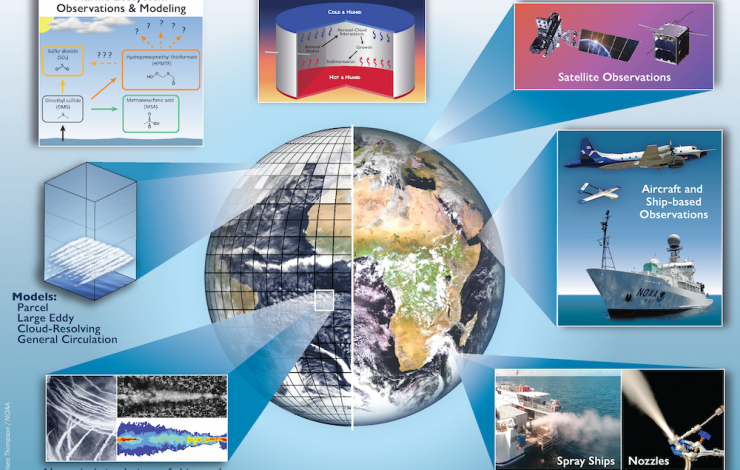
This diagram depicts the key aerosol, cloud, dynamics, and radiation processes in the marine boundary layer (left) and the MCB approach using ship-based generators to produce fine sea-salt aerosol droplets (right). The droplets are lofted into clouds by updrafts, where they increase droplet concentrations, extending the reflectivity coverage and lifetime of the clouds. Credit: After Sorooshian et al. 2019.

An integrated approach to a MCB research program comprising laboratory facilities, field experiments, and modeling is depicted. Earth view image is courtesy of the European 336 Organisation for the Exploitation of Meteorological Satellites (EUMETSAT), with modifications to highlight ship tracks and model mesh. Credit: Chelsea Thompson/NOAA
As the levels of greenhouse gases in the atmosphere continue to increase and climate change impacts become more costly, the scientific community is redoubling efforts to investigate the potential risks and benefits of artificially shading Earth’s surface to slow global warming.
Marine cloud brightening (MCB) proposals involve the injection of salt spray into shallow marine clouds to brighten them, increasing their reflection of sunlight and reducing the amount of heat absorbed by the water below.
A group of 31 leading atmospheric scientists, among them PMEL atmospheric chemist Patricia Quinn, have offered a consensus physical science research roadmap to build the knowledge base needed to evaluate the viability of MCB approaches. Their roadmap is described in a new paper published in the journal Science Advances.
"Interest in MCB is growing, but policymakers currently don’t have the information they need to reach decisions about if and when MCB should be deployed,” said lead author Graham Feingold, a researcher with NOAA’s Chemical Sciences Laboratory. “The question is whether we can design a MCB research program using our current modeling and observational tools to establish the feasibility of this approach on a global scale, and if not, what needs to be done to position ourselves to do so."
Co-author Lynn Russell, a climate scientist at the Scripps Institution of Oceanography at the University of California San Diego added that a research plan is essential before considering whether to adopt MCB. "We need to simultaneously address the physical science questions and the human dimensions," Russell said.
Current MCB proposals rely on saltwater spray, which would mimic plumes of sulfur-rich emissions from ship stacks or volcanoes, to increase the aerosol concentration in the lower marine atmosphere. Ideally, droplets in the saltwater spray evaporate to produce fine particles that are carried up to the cloud layer by turbulent and convective air motions. The study proposes a substantial and targeted program of MCB research that includes laboratory studies, field experiments, and cloud modeling, along with new laboratory facilities to address aerosol and cloud microphysical processes.
In practical terms, researchers need to develop sufficient confidence that appropriately sized particles can be generated and delivered to the clouds, and act to form cloud droplets that efficiently scatter sunlight. They would need to show that clouds could be brightened consistently and over a large enough area to meaningfully cool the ocean below. Scientists would further need to show that the brightening of the clouds would be measurable to demonstrate it would work as intended at globally relevant scales, or in sensitive regional ecosystems, such as coral reefs.
"We would have to get the right-sized particles into receptive clouds at the right times of day and seasons, and over large-enough areas to shade large areas of ocean," said Feingold. "It’s a major challenge."
Feingold emphasized that MCB would not replace decarbonization and would not alleviate ocean acidification. "To reduce global temperatures, our highest priority should be to remove carbon dioxide from the atmosphere. MCB might help to alleviate the worst impacts of climate change."
For more information, contact Theo Stein, NOAA Communications: theo.stein@noaa.gov.
A copy of the paper may requested from Science Advances, at: https://www.science.org/journal/sciadv
This story was adapted from an article posted on NOAA Research.


